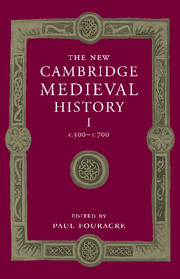
-
Select format
-
- Publisher:
- Cambridge University Press
- Publication date:
- March 2008
- December 2005
- ISBN:
- 9781139053938
- 9781107449060
- Dimensions:
- Weight & Pages:
- Dimensions:
- (229 x 152 mm)
- Weight & Pages:
- 1.32kg, 1008 Pages
You may already have access via personal or institutional login
Book description
The first volume of The New Cambridge Medieval History covers the transitional period between the later Roman world and the early middle ages, c.500 to c.700. This was an era of developing consciousness and profound change in Europe, Byzantium and the Arab world, an era in which the foundations of medieval society were laid and to which many of our modern myths of national and religious identity can be traced. This book offers a comprehensive regional survey of the sixth and seventh centuries, from Ireland in the west to the rise of Islam in the Middle East, and from Scandinavia in the north to the Mediterranean south. It explores the key themes pinning together the history of this period, from kingship, trade and the church, to art, architecture and education. It represents both an invaluable conspectus of current scholarship and an expert introduction to the period.
Reviews
'The New Cambridge Medieval History is complete. … Paul Fouracre has provided a worthy addition to this prestigious series. … the volume includes excellent surveys of Scandinavian history by Lotte Hedeager, Slavic history by Zbigniew Kobylinski and numerous essays on the British Isles. … coverage of early medieval European history is thorough and balanced. … especial praise must be given to the excellent summary of 'The barbarian invasions' by Guy Halsall - sure to become indispensable to a new generation of undergraduates - to Simon Loseby's stimulating account of 'The Mediterranean economy' and, perhaps most strikingly, to Michael Toch's discussion of 'The Jews in Europe, 500–1050', which takes the reader beyond the chronological confines of the volume as a whole, but with richly rewarding results. … the contributions are all fluidly written, stimulating and a pleasure to read. The comprehensive index and useful thematic bibliographies further ensure that this volume will be an essential reference tool for years to come.'
Source: Journal of Ecclesiastical History
Contents
Metrics
Altmetric attention score
Full text views
Full text views help Loading metrics...
Loading metrics...
* Views captured on Cambridge Core between #date#. This data will be updated every 24 hours.
Usage data cannot currently be displayed.
Accessibility standard: Unknown
Why this information is here
This section outlines the accessibility features of this content - including support for screen readers, full keyboard navigation and high-contrast display options. This may not be relevant for you.
Accessibility Information
Accessibility compliance for the PDF of this book is currently unknown and may be updated in the future.


